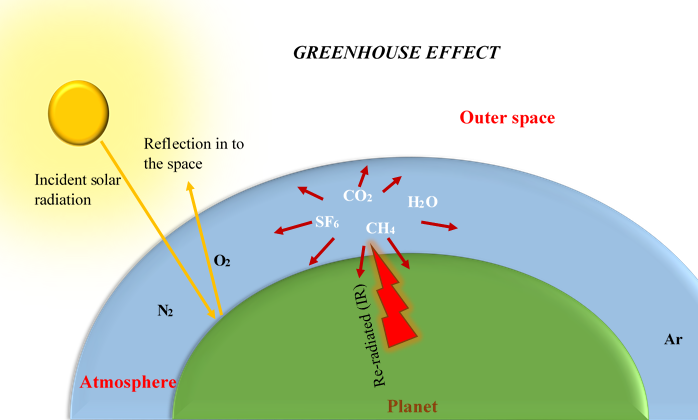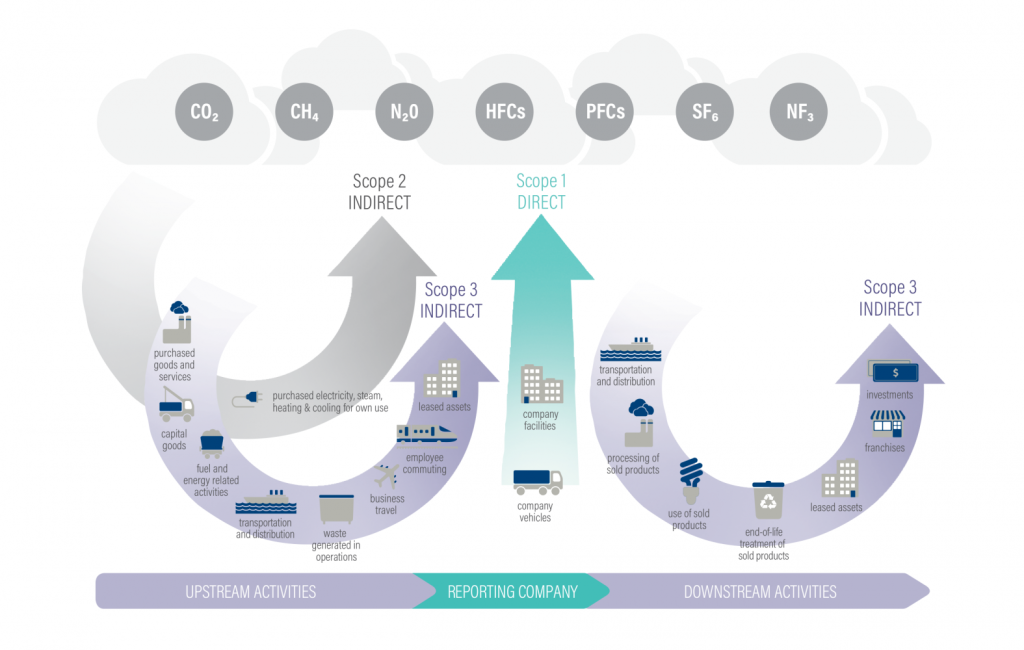The world around us is filled with invisible actors, playing crucial roles in the health of our planet and our own well-being. Among these are gases that, while unseen, exert a profound influence on the Earth’s climate and the quality of the air we breathe. Understanding these invisible giants – greenhouse gases and air quality gases – along with the concept of emissions scopes, is fundamental to navigating the challenges of environmental sustainability and climate change in the 21st century. This report delves into these critical topics, providing a comprehensive overview of their definitions, examples, impacts, and significance for both the environment and organizations striving for a more sustainable future.
Table of Contents
ToggleWhat Exactly Are Greenhouse Gases?
The Science Behind the Greenhouse Effect
The journey of energy to and from our planet begins with the sun. Solar radiation reaches the Earth, warming its surface. This warmth is then radiated back into space as infrared radiation, essentially heat. However, certain gases in the atmosphere possess a unique ability to absorb and emit this infrared radiation, trapping a portion of the heat and preventing it from escaping entirely. This natural phenomenon is known as the greenhouse effect, and the gases responsible for it are called greenhouse gases (GHGs) . The Intergovernmental Panel on Climate Change (IPCC) defines these gases as “gaseous constituents of the atmosphere, both natural and anthropogenic, that absorb and emit radiation at specific wavelengths within the spectrum of radiation emitted by the Earth’s surface, by the atmosphere itself, and by clouds” . This process is analogous to how a greenhouse keeps plants warm; the glass allows sunlight in but traps the heat inside .

The natural greenhouse effect is vital for life on Earth. It maintains the planet’s average temperature at a habitable level of around 15°C (59°F). Without this natural insulation, the Earth’s average temperature would plummet to approximately -18°C (0°F), far too cold to support most forms of life . However, human activities since the Industrial Revolution have significantly increased the concentration of these heat-trapping gases in the atmosphere. This intensification of the natural greenhouse effect is referred to as the enhanced greenhouse effect . The consequence of this enhancement is global warming, as more heat is trapped, leading to a rise in the planet’s average temperature and significant disruptions to the climate system .
Common Culprits: Examples of Greenhouse Gases
A variety of gases contribute to the greenhouse effect, some occurring naturally and others resulting from human activities . The most significant greenhouse gases include water vapor (H2O), carbon dioxide (CO2), methane (CH4), nitrous oxide (N2O), ozone (O3), and fluorinated gases . Each of these gases has different sources and varying abilities to trap heat.
- Carbon Dioxide (CO2) is the most abundant anthropogenic greenhouse gas and a primary driver of climate change . Its main sources include the burning of fossil fuels for energy (power plants, vehicles, industry), deforestation (which reduces the planet’s capacity to absorb CO2), and certain industrial processes like cement production . CO2 is naturally present in the carbon cycle, but human activities have drastically increased its atmospheric concentration, and it possesses a long residence time, meaning it persists in the atmosphere for centuries .
- Methane (CH4) is a more potent greenhouse gas than CO2 over shorter timeframes . Its primary sources include agricultural activities (especially livestock and rice farming), the production and distribution of natural gas and petroleum, the decomposition of organic waste in landfills, and natural sources like wetlands . Over a 100-year period, methane has a Global Warming Potential (GWP) of 28, indicating it traps 28 times more heat per molecule than CO2 .
- Nitrous Oxide (N2O) is another powerful greenhouse gas with a long atmospheric lifetime . It is emitted from agricultural practices (such as fertilizer use), industrial processes, and the combustion of fossil fuels and solid waste . Its GWP over 100 years is 273, making it significantly more effective at trapping heat than CO2 .
- Fluorinated Gases (F-gases) are synthetic gases used in various industrial applications, including refrigeration, air conditioning, and aerosol propellants . These gases, such as hydrofluorocarbons (HFCs), perfluorocarbons (PFCs), sulfur hexafluoride (SF6), and nitrogen trifluoride (NF3), have exceptionally high GWPs, often thousands of times greater than that of CO2 . For instance, sulfur hexafluoride (SF6), used in electrical equipment, has a GWP of 23,000 .
The relative impact of each greenhouse gas on global warming is determined by its concentration in the atmosphere, its ability to absorb and radiate energy (radiative efficiency), and the length of time it remains in the atmosphere (atmospheric lifetime) . The concept of Global Warming Potential (GWP) provides a way to compare the heat-trapping abilities of different greenhouse gases relative to carbon dioxide over a specific period, typically 100 years .
Breathing Easier? An Introduction to Air Quality Gases
Defining the Air We Breathe: What Are Air Quality Gases?
While greenhouse gases are the primary drivers of long-term climate change, air quality gases, also known as air pollutants, are substances in the atmosphere that can have detrimental effects on human health, the environment, and even damage property . These pollutants encompass a wide range of gaseous and particulate matter that, when present in sufficient concentrations, can pose significant risks. The Environmental Protection Agency (EPA) plays a crucial role in regulating these substances through the establishment of National Ambient Air Quality Standards (NAAQS), which define acceptable levels of common air pollutants to protect public health and welfare .

The Usual Suspects: Examples of Air Quality Gases
The EPA has identified six main “criteria” air pollutants that are common throughout the United States and can harm human health and the environment . These include ozone (O3), particulate matter (PM), carbon monoxide (CO), sulfur dioxide (SO2), nitrogen dioxide (NO2), and lead (Pb).
- Ozone (O3) at ground level is a significant air pollutant formed through chemical reactions between volatile organic compounds (VOCs) and nitrogen oxides (NOx) in the presence of sunlight . Exposure to ground-level ozone can cause a variety of respiratory problems, including coughing, wheezing, and reduced lung function, and can also damage vegetation .
- Nitrogen Oxides (NOx) are a group of highly reactive gases, with nitrogen dioxide (NO2) being the most common. They are primarily emitted from the burning of fossil fuels in vehicles, power plants, and industrial facilities . NOx can irritate the respiratory system, contribute to the formation of smog and acid rain, and contribute to nutrient pollution in coastal waters .
- Sulfur Dioxide (SO2) is a pungent gas primarily released from the burning of fossil fuels, especially coal and oil, as well as from industrial processes and volcanic activity . SO2 can irritate the respiratory system, make breathing difficult, and contribute to acid rain and the formation of particulate matter .
- Particulate Matter (PM) is a complex mixture of solid particles and liquid droplets suspended in the air. It includes particles of various sizes, such as PM10 (inhalable coarse particles) and PM2.5 (fine inhalable particles) . Sources include the combustion of fossil fuels, industrial processes, construction, agriculture, wildfires, and dust . Inhalation of particulate matter can lead to a range of respiratory and cardiovascular problems .
- Carbon Monoxide (CO) is a colorless, odorless gas produced by the incomplete combustion of carbon-containing fuels such as natural gas, gasoline, and wood . CO is harmful because it reduces the ability of blood to carry oxygen to the body’s organs and can cause headaches, dizziness, and even death at high concentrations .
- Lead (Pb) is a toxic metal that was historically emitted into the air primarily from leaded gasoline . While its use in gasoline has been largely phased out, lead can still be emitted from sources like ore and metal processing and the combustion of aviation gasoline . Lead can accumulate in the body and cause neurological damage, particularly in children, as well as kidney problems and other health issues .
While some air quality gases, such as ozone, can also act as greenhouse gases, their primary focus from a regulatory and impact perspective is on local air quality and the immediate effects on human health and the environment.
Greenhouse Gases vs. Air Quality Gases: What’s the Difference?
Primary Focus: Climate vs. Health
The fundamental distinction between greenhouse gases and air quality gases lies in their primary effects. Greenhouse gases are the key drivers of global climate change, influencing the Earth’s long-term temperature and climate patterns by trapping heat in the atmosphere . In contrast, air quality gases primarily impact the immediate health of humans and the local environment by affecting the composition of the air we breathe . While the former contributes to a global fever, the latter causes more localized and immediate ailments.
Regulation and Monitoring: Different Approaches
The regulatory and monitoring frameworks for greenhouse gases and air quality gases often differ, reflecting their distinct primary impacts. Air quality gases in the United States are primarily regulated under the Clean Air Act, which mandates the setting of National Ambient Air Quality Standards (NAAQS) for the six criteria pollutants . The air quality in different regions is monitored against these standards, and the Air Quality Index (AQI) is used to communicate the levels of these pollutants to the public .
While there are international agreements aimed at reducing greenhouse gas emissions, such as the Kyoto Protocol and the Paris Agreement , the United States does not have federal regulatory standards for greenhouse gases that are directly comparable to the NAAQS for air quality gases . Instead, greenhouse gas emissions are tracked and reported by various entities, including the EPA, and policies are implemented to encourage their reduction . It is worth noting that efforts to mitigate one type of gas can often yield benefits for the other, leading to co-benefits in addressing both climate change and air pollution.
Decoding Emissions: Scope 1, 2, and 3 Explained
To better understand and manage greenhouse gas emissions, particularly within the context of businesses and organizations, the concept of emissions scopes has been developed . These scopes categorize emissions based on their source and the level of control an organization has over them, providing a framework for comprehensive emissions accounting and the identification of reduction opportunities across the entire value chain.

Scope 1: Emissions Within Our Walls
What Counts as Scope 1?
Scope 1 emissions are defined as direct greenhouse gas emissions that occur from sources that are owned or controlled by an organization . These are emissions that a company directly releases into the atmosphere through its activities.
Real-World Examples of Scope 1 Emissions
Examples of Scope 1 emissions are diverse and vary depending on the industry. They include the combustion of fuels in stationary sources like boilers and furnaces for heating or industrial processes, as well as in mobile sources such as company-owned vehicles (trucks, cars, planes) and heavy machinery . Process emissions from industrial activities, where greenhouse gases are released during manufacturing or chemical processes (e.g., CO2 from cement production, GHGs from metal smelting), also fall under Scope 1 . Additionally, fugitive emissions, which are unintentional releases of greenhouse gases like methane leaks from oil and gas infrastructure or refrigerant leaks from air conditioning systems, are categorized as Scope 1 emissions . In the agricultural sector, emissions from livestock and the use of fertilizers on company-owned land are also considered Scope 1 .
Strategies for Tackling Scope 1
Organizations have several strategies at their disposal to reduce their Scope 1 emissions. Improving energy efficiency across operations can significantly lower fuel consumption . Transitioning to renewable energy sources for on-site power generation or heating, such as installing solar panels or using biofuels, can replace fossil fuels and decrease direct emissions . Optimizing vehicle fleets by switching to electric or hybrid vehicles or improving fuel efficiency can reduce emissions from transportation . Implementing robust leak detection and repair programs is crucial for minimizing fugitive emissions, particularly in industries dealing with natural gas or refrigerants . Because Scope 1 emissions are directly controlled by the organization, they often represent the most straightforward area for implementing emission reduction measures.
Scope 2: The Power We Consume
Understanding Indirect Emissions from Energy
Scope 2 emissions are indirect greenhouse gas emissions that result from the generation of purchased or acquired electricity, steam, heat, or cooling consumed by the reporting company . Although these emissions physically occur at the facility where the energy is produced, they are accounted for in an organization’s GHG inventory because they are a direct consequence of the organization’s energy use.
Examples of Scope 2 Emissions
Common examples of Scope 2 emissions include the greenhouse gases released by power plants to generate the electricity used to power a company’s buildings, machinery, and equipment . This encompasses electricity used for lighting, heating, ventilation, air conditioning, and various industrial processes. Additionally, if an organization purchases steam or heat for industrial processes or building heating from a third-party provider (like a district heating system), the emissions associated with the generation of that steam or heat are also classified as Scope 2 . Similarly, emissions from purchased cooling, such as chilled water for air conditioning, are included in Scope 2 .
Location-Based vs. Market-Based Accounting
The GHG Protocol provides two methods for calculating Scope 2 emissions: the location-based method and the market-based method . The location-based method uses average emission factors for the electricity grids where the energy consumption occurs, reflecting the overall carbon intensity of the grid . The market-based method, on the other hand, reflects emissions from the electricity that companies have specifically chosen through contractual instruments, such as renewable energy certificates (RECs) or power purchase agreements (PPAs) . Often, organizations are required to report their Scope 2 emissions using both methods, known as dual reporting .
Ways to Shrink Your Scope 2 Footprint
Reducing Scope 2 emissions can be achieved through various strategies. Implementing energy efficiency measures to decrease overall energy consumption is a key step . Transitioning to renewable energy sources, either by generating it on-site (e.g., through solar panels) or by purchasing it through green tariffs or power purchase agreements, directly reduces the emissions associated with electricity use . Purchasing renewable energy certificates (RECs) is another way for companies to support renewable energy generation and reduce their market-based Scope 2 emissions . Given that energy consumption is a significant contributor to many organizations’ carbon footprints, addressing Scope 2 emissions is crucial for achieving substantial reductions.
Scope 3: The Ripple Effect of Our Value Chain
The Broad Reach of Scope 3 Emissions
Scope 3 emissions encompass all other indirect greenhouse gas emissions that occur in a company’s value chain, both upstream and downstream, and are not included in Scope 2 . These emissions result from activities of assets not owned or controlled by the reporting organization but are indirectly influenced by it . For many organizations, Scope 3 emissions represent the largest portion of their total greenhouse gas emissions .
Upstream vs. Downstream: A Closer Look
Scope 3 emissions are broadly categorized into upstream and downstream emissions . Upstream emissions relate to purchased goods and services, capital goods, fuel- and energy-related activities (not included in Scope 1 or 2), upstream transportation and distribution, waste generated in operations, business travel, employee commuting, and upstream leased assets . Downstream emissions include downstream transportation and distribution, processing of sold products, use of sold products, end-of-life treatment of sold products, downstream leased assets, franchises, and investments . The GHG Protocol identifies 15 specific categories within Scope 3 emissions .
Examples Across the Value Chain
Examples of upstream Scope 3 emissions include emissions from the extraction, production, and transportation of raw materials purchased by a company; the manufacturing of capital goods like machinery and equipment; the upstream emissions associated with the production and transportation of fuels and energy consumed by the company; and emissions from business travel and employee commuting .
Downstream Scope 3 emissions examples include emissions from the transportation and distribution of a company’s sold products to the end consumer; the processing and use of intermediate products sold to other companies; the emissions generated by customers using the products sold by the reporting company; and the emissions associated with the disposal or recycling of those sold products at the end of their life .
The Challenge and Importance of Measuring Scope 3
Accounting for Scope 3 emissions presents significant challenges due to the complexity and vastness of value chains, as well as the difficulty in obtaining accurate data from numerous external entities . Data availability can be limited, and estimations based on industry averages may be necessary . Despite these hurdles, measuring Scope 3 emissions is crucial because they often constitute the majority of an organization’s total carbon footprint and offer substantial opportunities for emissions reduction and value chain optimization .
Strategies for Influencing Scope 3 Emissions
Companies can employ various strategies to influence and reduce Scope 3 emissions. Engaging with suppliers to encourage them to adopt sustainable practices and reduce their own emissions is paramount . Implementing sustainable procurement policies that prioritize suppliers with lower carbon footprints can also drive reductions . Redesigning products to use lower-impact materials and improve energy efficiency during use can decrease both upstream and downstream emissions . Engaging customers to promote sustainable product use and end-of-life management is another important lever . Additionally, adopting operational policies focused on reducing waste and promoting sustainable transportation for employees can contribute to Scope 3 reductions . Aligning investment strategies with sustainability goals, such as investing in companies with strong environmental records, can also play a role in reducing Scope 3 emissions .
When Worlds Collide: The Interplay Between Greenhouse Gases and Air Quality
Gases with Dual Identities
Interestingly, some gases can act as both greenhouse gases and air pollutants, blurring the lines between these two categories . Ozone, for instance, while beneficial in the stratosphere for blocking harmful UV radiation, is a harmful air pollutant at ground level and also acts as a short-lived greenhouse gas . Nitrogen oxides contribute to smog and acid rain, impacting air quality, but also have some warming effect and are precursors to ozone . Even carbon dioxide, while primarily considered a greenhouse gas, can impact local air quality at very high concentrations .
The Co-Benefits of Emission Reduction
Efforts to reduce emissions often result in co-benefits for both climate change and air quality . For example, reducing the combustion of fossil fuels, a major source of greenhouse gases like CO2, simultaneously lowers emissions of harmful air pollutants such as particulate matter, nitrogen oxides, and sulfur dioxide . This means that actions taken to mitigate climate change can also lead to immediate improvements in air quality and public health . Electrifying transportation, for instance, can significantly reduce both carbon dioxide and nitrogen oxide emissions in urban areas . This interconnectedness highlights the potential for “win-win” strategies that address both environmental and health challenges.
Why Bother? The Significance of Understanding and Reporting Emissions
Environmental Sustainability and Responsibility
Understanding and reporting emissions is not merely a technical exercise but a fundamental aspect of environmental sustainability and corporate responsibility. It reflects a commitment to understanding and mitigating an organization’s impact on the planet and contributes to the broader goal of creating a sustainable future [various snippets].
Climate Change Mitigation Efforts
Accurate and comprehensive emissions reporting, particularly encompassing Scope 3 emissions, is crucial for effective climate change mitigation efforts. It provides the data necessary to understand the sources and magnitude of greenhouse gas emissions, enabling the setting of meaningful reduction targets and the tracking of progress towards those targets, including those aligned with global agreements like the Paris Agreement .
Benefits for Businesses and Organizations
Beyond the ethical imperative, understanding and reporting emissions offers numerous benefits for businesses and organizations . It allows for the identification of potential risks and opportunities within their operations and value chains, leading to improved resource efficiency and cost savings. Transparency in emissions reporting can enhance a company’s reputation and build trust with increasingly environmentally conscious consumers and investors. Furthermore, it helps organizations meet the growing expectations of stakeholders and navigate potential future regulations related to carbon emissions. By proactively addressing their emissions, businesses can enhance their long-term resilience and contribute to a more sustainable global economy.
Conclusion: A Breath of Fresh Air and a Stable Climate
The intricate relationship between greenhouse gases, air quality, and emissions scopes underscores the complexity and interconnectedness of our environmental challenges. Understanding these concepts is the first crucial step towards effective action. By recognizing the different roles these invisible giants play in our world and by diligently accounting for and reducing emissions across all scopes, we can strive towards a future characterized by cleaner air, a more stable climate, and a healthier planet for all. It is a collective responsibility that requires individuals, organizations, and governments to work together towards a sustainable future.
Frequently Asked Questions (FAQs)
- What is the difference between a greenhouse gas and an air quality gas? Greenhouse gases primarily trap heat in the Earth’s atmosphere, contributing to global warming and climate change. Air quality gases, or air pollutants, primarily affect the quality of the air we breathe and can harm human health and the environment locally. While some gases can fall into both categories, their primary impacts and regulatory frameworks differ.
- Why is it important for businesses to track Scope 3 emissions if they don’t directly control them? Scope 3 emissions often represent the largest portion of a company’s total carbon footprint, as they encompass emissions from the entire value chain, including suppliers and customers. Understanding and addressing these emissions is crucial for a comprehensive climate strategy, identifying significant reduction opportunities, and engaging with stakeholders who increasingly scrutinize a company’s overall environmental impact.
- What are some practical ways a company can reduce its Scope 2 emissions? Companies can reduce their Scope 2 emissions by implementing energy efficiency measures to lower their overall energy consumption. They can also switch to renewable energy sources by installing on-site generation like solar panels, purchasing green electricity tariffs from their utility provider, entering into power purchase agreements (PPAs) with renewable energy projects, or buying renewable energy certificates (RECs) to offset their electricity use.
- Can reducing air pollution also help with climate change? Yes, many sources of air pollution also emit greenhouse gases. Reducing the combustion of fossil fuels, for example, lowers emissions of both air pollutants like particulate matter and nitrogen oxides, and greenhouse gases like carbon dioxide. Additionally, some air pollutants, like black carbon and ground-level ozone, are also short-lived climate pollutants that contribute to warming, so reducing them has a dual benefit.
- Why are international agreements like the Paris Agreement important for addressing greenhouse gas emissions? Greenhouse gas emissions have a global impact, affecting the climate of the entire planet. International agreements like the Paris Agreement provide a framework for countries to cooperate and set collective goals for reducing greenhouse gas emissions. This global cooperation is essential because no single country can solve the problem of climate change alone. These agreements facilitate the sharing of knowledge, technologies, and financial resources to support a global transition to a low-carbon economy.







